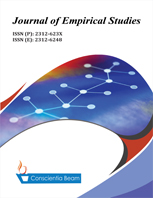Nexus among Foreign Exchange Reserve, Remittance and Trade Openness: An Empirical Investigation in the Case of Bangladeshi Economy
DOI:
https://doi.org/10.18488/journal.66.2021.81.1.12Abstract
This study has explored the nexus among foreign exchange reserve, remittance, exchange rate, and trade balance in Bangladesh for the period of 1986 to 2019. By employing the Autoregressive Distributed Lag (ARDL) bound test approach, a long-run equilibrium relationship among the variables has been found. The study has shown a statistically significant positive impact of remittance inflow and trade balance on foreign exchange reserves in the long run. If remittance inflow increases by 1 percent, then the foreign exchange reserve would increase by 0.43 percent, and if trade openness rises by 1 percent, then the foreign exchange reserve would rise by 1.22 percent. Granger causality test has revealed the presence of unidirectional causality from the remittance inflow to foreign exchange reserve and remittance inflow to exchange rate. Bidirectional causality has observed between trade openness and exchange rate; however, no causal relationship exists between reserve and trade openness. Based on the findings, this study has endorsed several policy directions that Bangladesh can take to excel in the 21st century and cope with post-pandemic challenges.

